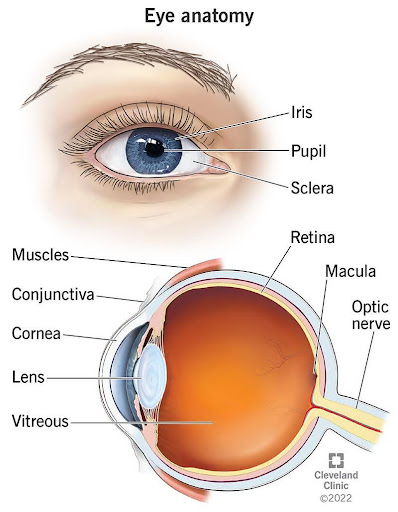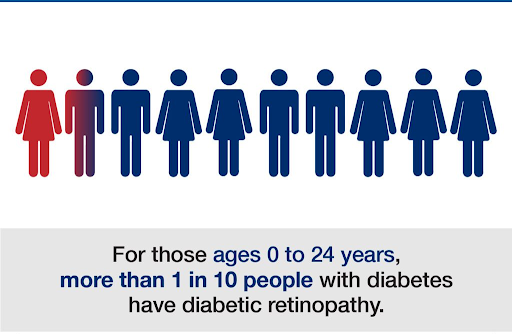
source
The vision function in your eye begins when light travels through the pupil, the small opening in the center. This light then reaches the retina at the back. The iris, which gives your eye its color, is responsible for adjusting the pupil's size to control the amount of light that enters. The lens, a transparent structure inside your eye, works with the cornea to fine-tune the focus of the light onto the retina.
The retina's job is to detect light through special cells and convert it into neural signals. These messages are sent to the brain through the optic nerve, which acts like a cable, allowing the brain to interpret these messages into the pictures we see.
When there is an issue with any part of this entire system, it can disrupt your vision. Without proper treatment, some visual impairments might even cause permanent blindness. In this post, our eye care specialists at Naper Grove Vision Care will discuss the most common eye diseases and vision problems to watch out for, so you can recognize the signs and seek appropriate medical intervention.
Cataracts
A cataract clouds up the lens in your eye and makes it hard to see. According to the American Academy of Ophthalmology, more than 20.5 million Americans over the age of 40 suffer from cataracts; this condition is also one of the leading causes why people lose their sight.
It can happen to anyone, no matter their age, and can even be a problem from birth. To treat cataracts, you might need to update your eyewear or add more lighting where you live and work. In cases where the vision gets much worse, surgery might be needed to replace the lens in your eye to help you see clearly again.
Symptoms: Blurred vision; difficulty with vision at night; sensitivity to light and glare; need for brighter light for reading and other activities; seeing "halos" around lights; frequent changes in eyeglass or contact lens prescription; fading or yellowing of colors; and double vision in a single eye.
Refractive Errors
Refractive errors occur when the shape of your eye stops light from focusing correctly, resulting in blurred vision. It includes myopia (difficulty seeing far away); hyperopia (trouble with seeing things close up); astigmatism (blurred vision at any distance); and presbyopia, which starts between the ages of 40 and 50 and affects your ability to see things close to you, like reading text on your phone or a newspaper.
Correcting these issues with the appropriate eyeglasses, contacts, or possibly surgery can significantly improve vision. Laser surgery may also be recommended to fix the cornea's shape to correct how light is focused inside the eye.
Symptoms: Your symptoms will depend on exactly what type of refractive error you have, but common signs are: blurred vision; double vision; hazy vision; seeing glare or halos around lights; squinting; headaches; eye strain; and difficulty driving at night.
Diabetic Retinopathy

source
Over time, diabetes can damage the retina's blood vessels, causing leaks and swelling in the retina. At first, you might not notice any vision disorders, but it can develop into symptoms like dark floating spots or blurred vision. The worst-case scenario is the retina detaching from the eye.
The good news is diabetic retinopathy can be treated with laser procedures or injections. More acute cases could require surgery. If you have diabetes, we also recommend taking steps to control your blood sugar, blood pressure, and cholesterol. Make sure to get your eyes examined every few months because early detection is key to effective treatment.
Symptoms: Blurred vision; fluctuating vision; impaired color vision; dark or empty areas in your vision; vision loss; spots or dark strings floating in your vision (floaters); and difficulty seeing at night.
Glaucoma
Glaucoma groups together several diseases damaging the optic nerve, which are essential for vision, and can cause loss of sight or complete blindness. Traditionally associated with higher internal eye pressure, it’s now known to occur even when this pressure is within the normal range. The most widespread form in the U.S. is open-angle glaucoma, which happens when the eye's fluid does not drain correctly.
It might not cause symptoms immediately but can slowly impair vision, starting from the outer edges. Treatments include eye drops or laser procedures to decrease eye pressure, or surgery to allow the fluids to flow.
Symptoms: Peripheral vision loss (initially); tunnel vision (in advanced stages); severe eye pain; nausea and vomiting (accompanying eye pain); red eyes; blurred vision; halos around lights; and eye tenderness.
Lazy Eye
Amblyopia, also known as "lazy eye," tops the list of vision impairments in children. This is where vision in one eye is reduced because it’s not working in sync with the brain, despite the eye appearing normal. It can be caused by the eyes not aligning correctly, one eye being more nearsighted or farsighted, or less commonly, by other eye issues like cataracts.
If not treated early on, amblyopia can continue into adulthood and turn into lasting vision problems in one eye. Treating amblyopia usually involves forcing the brain to use the weaker eye more by patching the stronger eye or using blurring drops, with additional treatments like glasses or surgery for underlying causes.
Symptoms: Poor depth perception; squinting or shutting an eye; eyes that do not appear to work together; abnormal visual screening test; head tilting; and an eye that wanders inward or outward.
Schedule Your Eye Examination Today
If you or someone you love is having concerns with your eyes, it’s time to get in touch with a vision care specialist at Naper Grove Vision Care. We offer comprehensive eye examinations for children and adults at our locations in Naperville and Downers Grove.
The tests we’ll administer may include:
Visual acuity test
Slit-lamp examination
Retinal exam
Refraction assessment
Keratometry/topography
Dilated eye exam
Optical coherence tomography (OCT)
Tonometry
Visual field test
To book an appointment with our optometrists today, contact us us at (630) 357-3511 (Naperville) or (630) 969-3268 (Downers Grove). If you or your child are having an emergency, call our 24-hour emergency line at (630) 357-7856